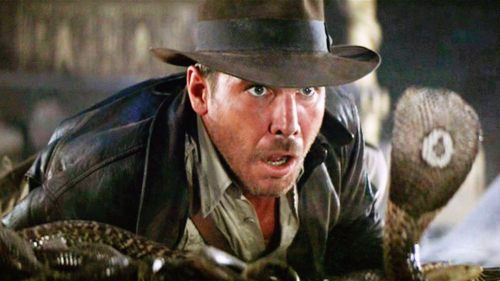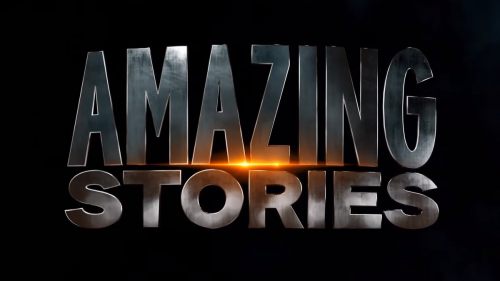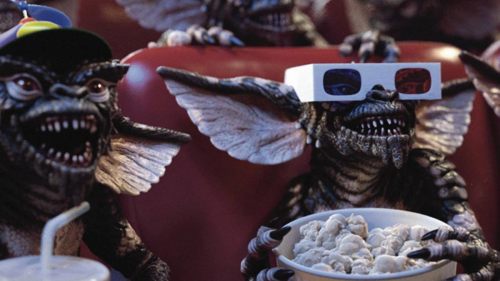Can READY PLAYER ONE Stand Out In A LEGO MOVIE World?
The trailer for the film adaptation of the 2011 Ernest Cline novel Ready Player One landed at SDCC 2017 last week, and aside from proving that the movie is a real thing that exists, it gave people a lot to chew on. With its whirlwind of pop-culture imagery and its Steven Spielberg director credit, it’s definitely one of the more curious major films of 2018. But it’d be way more curious were it released five years ago, before putting pop icons in a blender became commonplace.
Ready Player One takes place in 2045. The world is essentially unlivable, and people spend most of their time in an immersive, massively multiplayer online virtual reality world called the Oasis. It’s an impossibly huge universe filled with every conceivable activity, and thanks to its creator’s nostalgia for ‘80s video games, every conceivable icon of pop culture. The book and film revolve around a quest to solve a nigh-impossible series of challenges set by the Oasis’ creator. Thus, the world of Ready Player One is one where being good at video games and knowing obscure nerd trivia is a surefire path to success.
That would be shallow geek wish-fulfilment fantasy by itself, even if the novel didn’t get all its audience juice from nostalgic pop-culture recognition. In the Oasis, players can appear however they want and acquire whatever vehicles or items they want, if they can find them, meaning the universe is littered with Boba Fetts, Master Chieves, Wonder Women, Megazords, and so on. Put simply, Ready Player One’s Oasis is Skyrim with all the ridiculous mods turned on; or more to the point, Second Life as seen in Monster Factory.
When plumbing the depths of pop culture for references and cameos, of course, licensing deals have to be reached. Let’s dig into what properties can be seen in the trailer alone (hi, commenters: I already know I’m probably missing some and getting others wrong):
- “Pure Imagination,” from Willy Wonka and the Chocolate Factory (Universal Music Group)
- Harley Quinn and Deathstroke from DC Comics (WB/DC)
- Gandalf from The Lord of the Rings (WB)
- The Iron Giant (WB; will likely fight Mechagodzilla, also WB)
- Napoleon Bonaparte (uh...public domain, I guess)
- A giant scorpion from...Centipede? (Atari)
- Ostriches from Joust (Atari)
- Freddy from A Nightmare On Elm Street (WB/New Line)
- Duke Nukem (Gearbox)
- The DeLorean from Back to the Future (Amblin)
- “Tom Sawyer,” by Rush (Univeral Music Group)
- Christine (really just a Plymouth Fury)
- Lara Croft, Tomb Raider (Square Enix)
- The A-Team van (really just a GMC Vandura)
- Bigfoot, the original monster truck (really just a modified Ford F-series)
- Mad Max's signature ride (WB, but also just a modified Ford Interceptor)
- The bike from Akira (WB, which has a live-action film in development now)
Given that Ready Player One is a Warner/Amblin co-production, the theme on display shouldn’t come as any surprise. Most of the “hero” characters and vehicles - the Iron Giant, the DeLorean, the Akira motorcycle - come directly from the production companies’ back catalogues, as do many of the background characters. Licensing deals aren’t cheap, after all.
If you’re new to this and it all sounds a little bit like the Lego movies or Wreck-It Ralph - or god help us, Pixels - you’re not alone. Those films also deal heavily on nostalgia and pop-culture recognition, and in the Lego example, even draw from the same Warner Bros. library of licenses as Ready Player One. Hell, the first Lego Movie even has a similar story, with its hero learning to control the mechanisms through which its universe (in this case, Lego rather than virtual reality) operates. At least Wreck-It Ralph was smart enough (or bereft enough of official licenses? It did have a few) to synthesise its inspiration into analogues, but it had different things to say about its particular slice of culture.
Half a decade ago, Ready Player One's giddy mashup of icons - its “holy grail of pop culture,” as the trailer self-congratulatorily puts it - would have been something we'd never seen before. In the film’s release year of 2018, we’ll already be familiar with it. We're in the age of shared universes, “versus” movies, and Stranger Things, where crossovers don't just happen - they're almost expected from large-scale entertainment. Think how crazy a Batman/Superman movie seemed when a poster for one appeared in I Am Legend, just ten years ago. Now, it feels like small potatoes. Ready Player One merely represents a natural evolution of that trend; the Iron Giant fighting Freddy Krueger could actually end up invoking yawns rather than gasps (I exaggerate, obviously). Maybe the book was a little bit prophetic. Maybe its prophecy came true between the book’s publication and the film’s release.
One thing Ready Player One could do to set itself apart (but likely won't) is make a statement about its characters’ obsession with 1980s culture. Remember that in 2045, when the film is set, the 1980s will be as temporally distant as the 1950s are to today - not exactly the stuff kids flock to. There’s a point to be made in there about pop culture completely stalling around now-ish, and just continuing to re-digest and regurgitate itself for another thirty years. The existence of the Lego movies (not to mention current pop culture’s obsession with reviving old properties) would tend to support that in real life, despite the continued emergence of new cultural touchstones. But the book doesn’t go out of its way to make that point. Certainly, nostalgia is depicted as a soothing panacea to blot out the depressing reality of post-climate-disaster Earth, but Cline takes entirely too much joy in smashing his action figures together to make any kind of cogent statement. By and large, the book is the freewheeling culture jam the Oasis represents; its readers, Cline's future escapism-seekers.
What will Spielberg make of it all? He’s been kicking around long enough to see his own work become the subject of nostalgia - even, specifically, the nostalgia of Ready Player One - and he’s smart enough to elevate source material through loose and critical adaptations. The crucial element, I suspect, will be Spielberg’s treatment of its Willy Wonka figure, Oasis creator James Halliday, as played by Mark Rylance. The novel contains hints of Halliday having used ‘80s nostalgia as a means to escape a childhood that itself gets fetishised by Oasis players. There’s a sad, cyclical story in there, though again, it’s not mined thoroughly by the novel. But it’s precisely the kind of thing Spielberg might grab onto: after all, he’s something of a Wonka figure himself. Get ready for a slew of "Spielberg's latest film is really about filmmaking!" takes come March.
Ready Player One’s trailer surprised me with its desaturated, grimly-lit look; maybe Spielberg has something up his sleeve. Maybe he doesn’t. Or, more likely, maybe the film will join the Fight Club club in revelling too much in the culture it’s attempting to satirise (if it even tries to do that). Spielberg has earned the benefit of the doubt many times over, but if ever there was a project of his of which I was skeptical, it’s Ready Player One.



